A Bloody Dismal Fight
Late Medieval European Warfare in Miniature
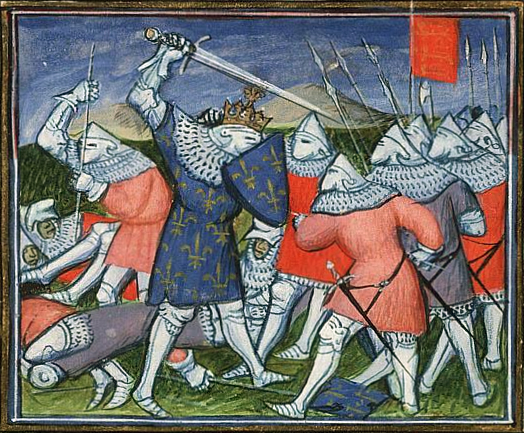
By Arofan Gregory. Copyright (c) 2020 Bloody Scotsmen Games LLC. All rights reserved.

By Arofan Gregory. Copyright (c) 2020 Bloody Scotsmen Games LLC. All rights reserved.
As those brave Edwards, Father, and the Sonne,
At Conquer’d Cressy, with successefull lucke,
Where first all France (as at one game) they wonne,
Never two Warriours, such a Battaile strucke,
That when the bloudy dismall fight was done,
Here in one heape, there in another Rucke
Princes and Peasants lay together mixt,
The English Swords, no difference knew betwixt.
-- Michael Drayton, Esq., "The Bataille of Agincourt" (1627)
By the 14th Century, chivalry was in decline, held up as an ideal but no longer practiced on the field of battle by the knights of the day. What had replaced it was perhaps less noble, mixing as it did the social orders, and seeming more the simple butchery that in fact it was. The Hundred Years' War and the Wars of the Roses had witnessed atrocities both on the field and off. The nobility was no longer safe, but had become vulnerable to death at the hands of commoners wielding the longbow, arbalest, cannon, and bill. Warfare was no longer a romantic quest, but had become something more serious: the "trade of kings" - an exercise in power.
Despite these changes - or, indeed, because of them - the art of war had entered a new era. While the later forms of discipline and order in warfare had yet to take hold, the late Middle Ages witnessed an increasing degree of skill on the part of commanders in the field. With the fading of the mounted knight as the unchallenged ruler of the battlefield, and the advent of the pike and longbow, the dynamics of warfare had changed, hinting at the trends which would bear fruit only centuries later, in the "pike & shot" era. The role of personal leadership on the battlefield was still pronounced, but was no longer sufficient unto itself. The best commanders of the time recognized this, and were able to overcome impressive odds by seeing the reality of what warfare had become.
These rules attempt to reproduce the dynamics of the era: armies are unwieldy, but not uncontrollable. The role of individual commanders is emphasized. Pike and bow are important, and field artillery can be deadly when deployed correctly. While mounted knights can be important, they are less so than the dismounted sort, as a result of the powerful weapons arrayed against them.
There are many excellent sets of rules for Ancient and Medieval wargaming (our current favorite is Art de la Guerre). This one was written to fill a specific niche which is poorly served: remote wargaming. The COVID-19 lock-downs have created a need for rules which depend less on incessant die-rolling and fine-tuned geometric positioning, as these things are difficult and slow when wargaming through cameras. Neither, it could be argued, are they as critical for the late Medieval period as they might be for Hellenistic and Classical warfare. Remote games benefit from more player activity: long periods spent sitting while the other player moves their entire army are less appealing when you are looking at everything through a camera. We have attempted to capture the best aspects of medieval rules systems, in a more interactive format, while using less finicky mechanics, and without the use of any physical dice whatsoever. The player's role as commander, both for controlling one's army and for winning important combats, is highlighted. The overall feel of the games is perhaps not too different from other game systems, but the mechanics are simplified and changed.
Another effect of these changes is to make the game more suitable for convention play than games such as Art de la Guerre. While extremely popular for tournament play. such systems are too difficult for players to easily learn for the sake of a single multi-player game. A Bloody Dismal Fight is well suited for such purposes, being extremely easy to learn and play.
These rules are designed for use with 25mm miniatures - the easiest popular scale to see when remote gaming - but could be played with smaller miniatures by substituting centimeters for inches, or halving base sizes, ranges, and distances. Popular basing systems will work (if you play DB*, Field of Glory, or ADLG no re-basing is required). The focus of the game is from the mid-14th century to the beginning of the 16th, covering the Hundred Years' War, the Wars of the Roses, the Burgundian conflicts, and the conflicts of the Condottieri in Italy. It is strictly limited in scope: field battles in Western Europe during the later Middle Ages. (This tight focus allows for much simplification, by reducing the number of troops types and tactics which must be accommodated.)
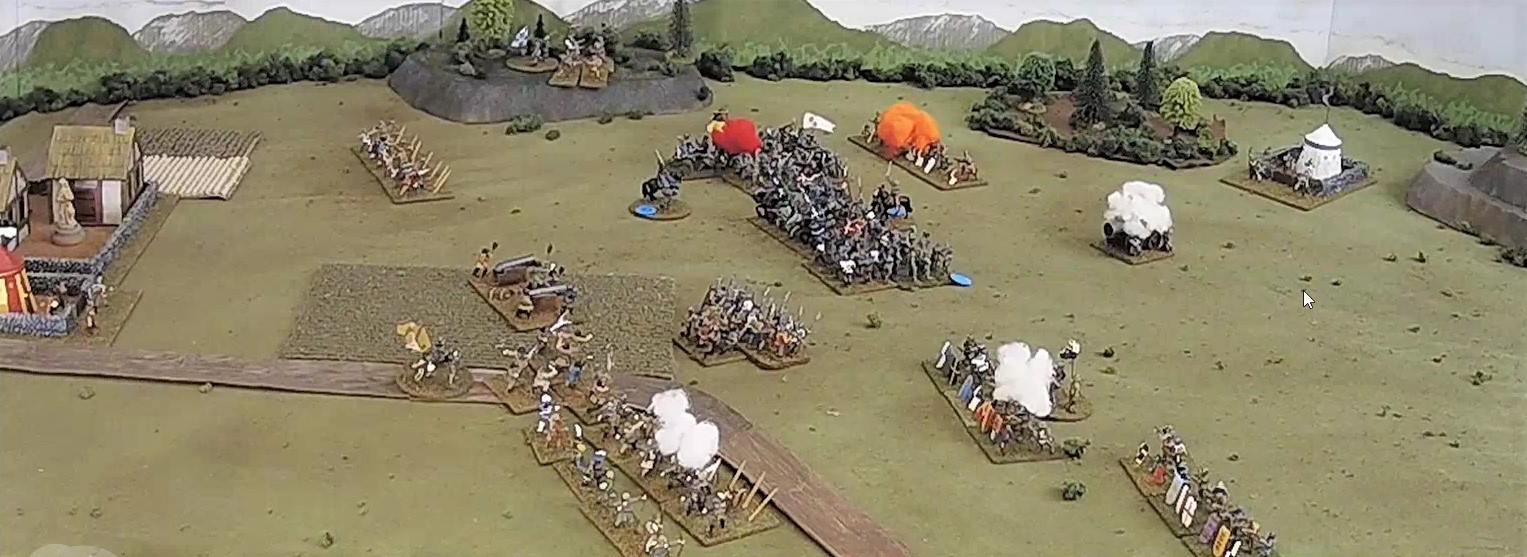
The tabletop viewed during play, as seen through a remote conferencing system. Blue chips mark units which have acted, and blobs of coloured cotton wool mark disorder and demoralization - such markers are easily seen by players viewing the action through a screen.
As with any miniatures game, figures and terrain are needed to represent the battlefield and combatants. This game is meant to represent entire field battles, and so is not a skirmish game in terms of tabletop representation. As with many Ancient and Medieval rules sets, exact man:figure ratios and ground scales are not specified. Miniatures may be understood to be representative, however: a couple of houses surrounded by a wall represent a village, etc. One figure is a larger number of actual combatants.
Rules and tape measures in inches are required for play. Dice are not. The game app will perform all needed randomization. Markers are needed for Disorder and Demoralization - further losses are expressed as base losses (see below on unit basing). Small chits or other markers for showing which units and Leaders have already acted during the turn are quite useful. The use of a tablet or smart phone during play (rather than a PC) is not critical, but may prove convenient. Only one device for running the game app is required, and it is used by the game master (or whoever is appointed to act in that capacity). The game app will run on PCs, tablets, and smart phones: any device with a javascript-capable web browser may be used. If desired, more than a single device may be used during play, but the "official" one for determining outcomes must be clearly identified for any given action.
A normal wargames table is required, although for most battles a fairly small one will suffice. 4 foot x 6 foot or larger is ideal. For smaller tables, players may wish to reduce figure scale to 15mm or smaller, and to reduce all distances and ranges by half, or replace inches with centimeters.
The following list provides all of the different troops types used in the game.
Mounted Knights/Men-at-Arms: Knights of all types and their retinues. They are heavily armored, and often ride on horses which also use protection. Their primary weapon is the lance. Despite their protection, they are still quite vulnerable to missile fire. Because of it, they are not incredibly maneuverable. Mounted knights may be deemed "undisciplined," which will impact their behavior on the battlefield, but not their capabilities. This designation is left up to the scenario.
Dismounted Knights/Men-at-Arms: Knights most often fought dismounted during this period. They are heavily armored, and generally use two-handed weapons such as pole axes.
Footmen/Billmen: Dense formations of infantry, typically armed mostly with bills, halberds, and similar weapons. They are not heavily armored, but are otherwise similar to dismounted knights in terms of their battlefield function.
Pikemen/Spearmen: These are dense formations of troops armed with long spears or pikes. They are capable of a modicum of discipline, and will present attackers with a hedge of spear points. This category includes spear-armed Scottish infantry, later Swiss pike formations, Welsh spearmen, Flemish pikemen, etc. While sometimes armored, they would not be as heavily armored as knights.
Archers: Archers in this era represent longbowmen, most typically English, but also coming from some other regions (e.g., Ordonnance or Italian longbowmen, Scottish archers). They are capable of a high rate of fire, and their weapons are reasonably good at piercing armor. They may be equipped with stakes by scenario.
Crossbowmen: The crossbows of the era were extremely powerful, but very slow to load. Crossbowmen routinely used pavises for protection in the open field, operating in fairly dense units. This type represents those denser formations - skirmishers armed with crossbows are classed as Irregulars in this game.
Levy: Militia infantry operating in dense formations, unarmored and equipped with a variety of hand weapons including swords, clubs, spears, staffs, bills, and so on.
Cannon: Lighter artillery pieces such as bombards and organ guns. At this period, heavier artillery was not commonly used on the battlefield, but lighter guns were becoming increasingly prevalent. They are still very slow to fire, however, and generally must be operated by specialists who see themselves as not responsible for hand-to-hand fighting!
Horsemen: Mounted crossbowmen, scouts, ginetes, sergeants, and similar types of non-knight horsemen. These troops may engage with missile weapons or the lance, and if armed with crossbows or handguns they will be capable of fire. In no case are they line-of-battle troops, however: they are useful to harrass the enemy, and may often run when charged. This was a fairly common troop type in some armies of the period, but generally in very small proportion to the other types. It should be noted that many "medium" cavalry types during this period (mounted archers, sergeants, etc.) generally dismounted to fight, and so are not represented in this game in a specific fashion. Mounted knights are assumed to include all of the different squires and so on who accompanied their lords into combat.
Irregulars: These troops may be armed with crossbows, bows, handguns, slings, javelins, or any combination of these, and will also carry hand weapons. They often wore some degree of armor. They operated in loose formations on foot. Unlike the classical image of light infantry, they were not averse to close combat, so long as it as in terrain which gave them a decent chance. Knights in heavy armor who have bogged down in the mud, for example, could easily become the targets of Irregulars! They will generally avoid close combat in the open.
Units will consist of 1 to 6 bases, all of the same type (a normal size unit will be 3 or 4 bases). Any troop type may come in any size unit, but some units such as Cannons and Horsemen tend to be only a base or two in size. The following chart defines base sizes for game purposes. Note that these bases may need to be composed of two single-rank physical bases, depending on how troops are mounted.
All units are based on a 60mm (2.5-inch) frontage. The number of figures is unimportant, but they should be of the appropriate troop type.
| Type | Base Depth |
| Leaders | 60mm (square or round) |
| Mounted Knights | 40mm |
| Dismounted Knights | 40mm |
| Footmen/Billmen | 40mm |
| Archers | 60mm |
| Crossbowmen | 60mm |
| Levy | 40mm |
| Pikemen | 60-90mm |
| Horsemen | 40mm |
| Irregulars | 30-40mm |
| Cannon | 60mm |
Note that the size of a unit at the start of play is significant. When a full half or more of the bases in a unit are destroyed, the unit is immediately removed from play. Units in this game represent the body of that troop type within a "battle," so a typical army will have three or four units in each of three or four battles, with each one commanded by a leader. (Because this is not intended as a tournament rules set, point values and army lists are not provided: these can be taken from the usual sources to provide a sense of proportions and relative values of different troops types).
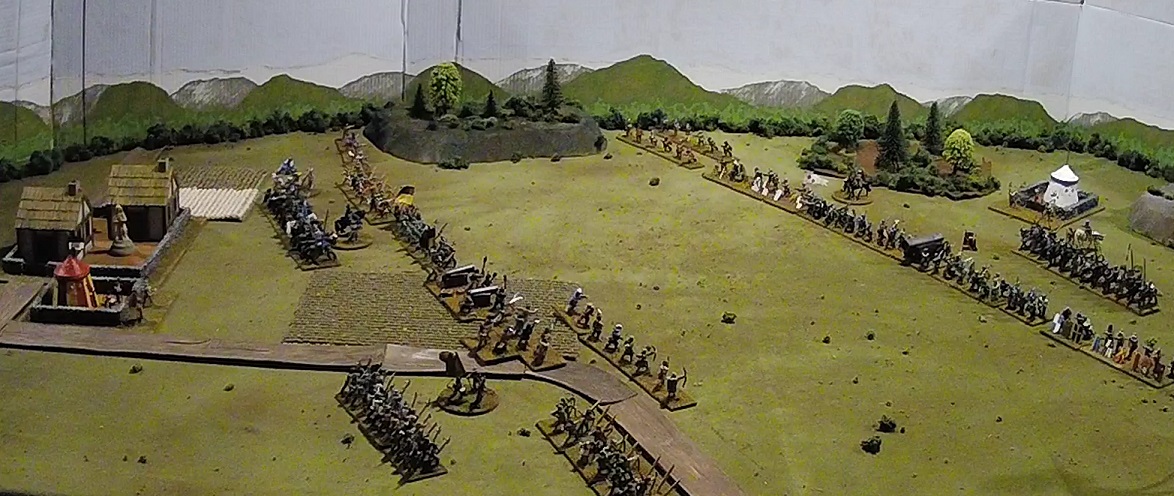
The armies have deployed and the battle is ready to begin! A table prepared for remote play, as seen through the wide-angle camera covering the whole table.
The game is played as a sequence of turns, during which each unit notionally makes a single action (there are exceptions). During each turn, each leader on the tabletop will be given a single initiative, and will have a set number of activations which can be used to act with the units under his or her command (it is always a bad idea to discount La Pucelle!).
One side is designated the Attacker, and the other the Defender (the terms are only meaningful by scenario). The turn sequence is:
Note that using markers to indicate which units and Leaders have acted can be a good idea (small colored chits work well for this).
The tabletop game is run basically in the same fashion as a traditional paper-and-dice game, but instead of rolling dice and looking modifiers and results up on charts, you simply consult the app. The sequence of events is still driven by players, following the steps listed above.
The app interface is shown below:
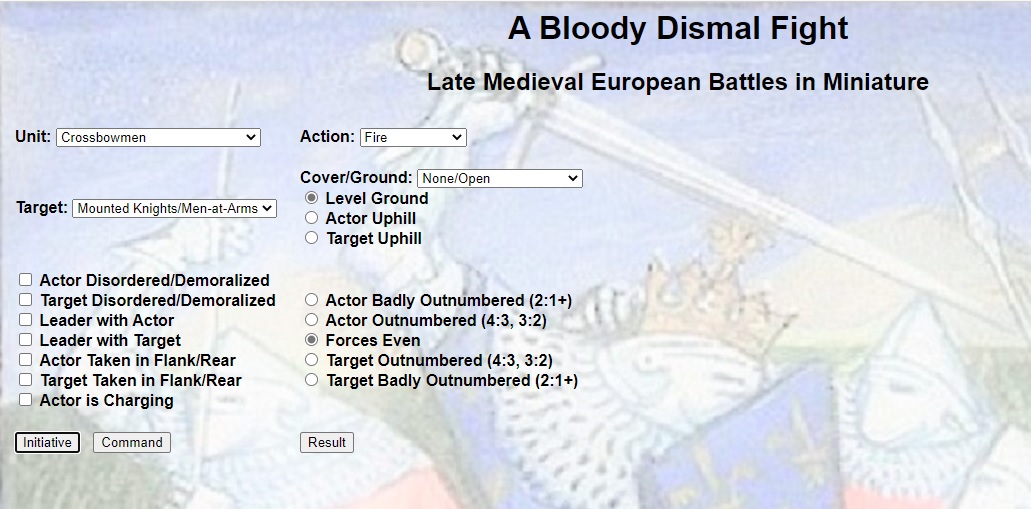
The Initiative and Command buttons are in the lower left-hand corner. Using these buttons requires no other fields to be set - you simply click, and a result box pops up, telling you which side has the initiative, or how many activations the Leader who is given the Initiative may use.
All other actions require that at least two of the app's controls be used: the "Unit" list, and the "Action" list. Other fields may also need to be set, as described in the Actions section, below. Once all needed fields have been set, the Result button in the lower right-hand corner is clicked, and a result box will pop up, explaining the results of the action, or asking a question.
When asked a question, "OK" always means "yes" and "Cancel" always means "no." Once any questions have been answered, a result box will appear. Click "OK" when you have read the result, to dismiss the box.
The screen below shows a result - a unit of knights has made a Melee action after charging into an enemy group of knights. The two units are the same size, and they are fighting in the open, but the attacker has charged downhill. The defender has gotten lucky - despite the advantages of the charging unit (height and impact), the result is a tie, throwing both units into disorder and continuing the fight.
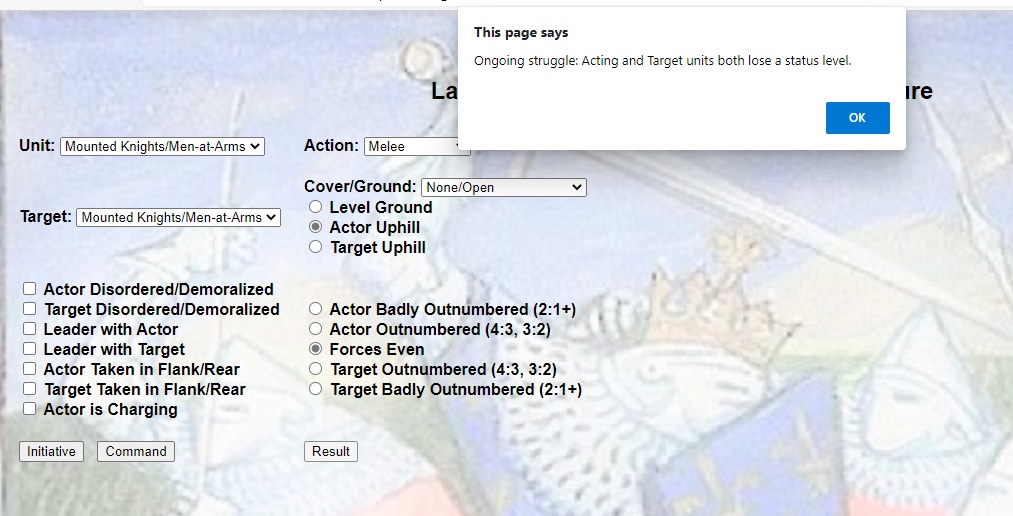
If at any point if you put the wrong values into the app fields, you may simply ignore the result, correct the settings, and click again. (You will need to "click through" any questions just by answering anything to make them go away.) Each click of the Result button is effectively a roll of the dice, but you can never keep a roll if you calculate the modifiers wrong! Think of the app interface as a checklist, which will help you remember all of the modifiers. As you learn the interface, you will find that it becomes easier to use, and that you will understand which actions use which fields. (Each field is essentially a dice modifier.)
Leaders are the commanders of the "battles" of a Medieval army, one of whom will generally be the overall commander of the entire host. Any given Leader will have a set of units which they may activate - the units in their battle, or, for the overall commander, any unit in the army.
Particularly good Leaders can be given a bonus rating, typically a +1. This will increase the number of activations they may use when they are given an Initiative by adding 1. An incredibly good Leader would be given a +2, and would increase the number of activations by 2 when given an Initiative.
Leaders have a command radius of 12 inches: any unit under their command within 12 inches of their base - measured between any part of the Leader's base, and any part of any base in the unit - may be given an activation once per turn. When activated, that unit will immediately make whatever valid action the player chooses (see Actions, below). The Leader may give as many activations as they have for that Initiative: the number granted by the app, plus their personal Leader bonus if they have one.
Leaders always also have a 24 inch base move each turn, which they may make before or after any activations are given to units (or even in the case that they give no activations to units). They may activate closer units, then move, and then activate units which they have brought within command range while moving. They may only move once during the turn, however, and may not activate units during the course of their move.
Leaders may take personal command of a single unit at any point, by placing themselves into contact with the base of that unit. This can help with some actions (such as Melee and Rallying). When attached to a unit, however, it is possible for a Leader to be killed or captured in Melee. Leaders who have fallen are not replaced, and count heavily against the army's morale. An attached Leader may still give activations to units to which they are not attached, and is not required to activate the unit they are with. Attached Leaders may detach from a unit at any time, unless the unit they are with is in an ongoing combat: once a Leader has been involved in a Melee action (with either the Acting unit or the Target), they may no longer move in that turn.
Leaders may not be targeted for fire or charges, and are only involved in melees with the units to which they are attached. If "run over," they simply make am immediate free move to take them out of the way. They may use this move to attach to a nearby friendly unit.
A Leader who is not using an Initiative, and who is involved in a Melee as a result of an enemy Melee Action, will be considered to have acted for the turn, and may no longer be given the Initiative during that turn. They are deemed to have been "caught up in the struggle"!
An army will have the ability to command all of its units as long as it still has a Leader on the table. When killed or captured, the command responsibility for that Leader is immediately assigned to any single surviving Leader at the player's discretion. When all Leaders have been killed or captured, the affected side may no longer make activations, although its units may still defend themselves in combat and fire on available targets at the end of each turn. With no Leaders, proactive charges and maneuvering are no longer possible.
Note that a Leader who is attached to a unit will move with that unit at the player's discretion, even if the Leader has already used its movement for the turn. Similarly, Leaders may always move with the units they are attached to for any reason, in addition to their own independent move for the turn. Thus, a unit making a Retire action with an attached Leader would bring that Leader with it, and the Leader could then use his own movement to go elsewhere during the turn.
The following is a list of the actions which may be taken in the game, as listed in the app "Action" list:
Rest/Regroup: This is the action taken if a unit chooses to do nothing (which does not actually require the app to perform), but is also used to Regroup (also called "rallying"). You must select the unit which will make the action, using the "Unit" list, and indicate if they have a Leader with them by checking the "Leader with Actor" box. No other fields are relevant. A Regroup action - if successful - will raise the Status Level of a unit by one (from Disordered to OK or Demoralized to Disordered) or by two (Demoralized or Disordered to OK). Regroup actions may be made by units involved in ongoing combats, but only if they have a Leader with them. In this case, the Melee action is immediately resolved (see below).
Advance: This is the most common move action, allowing a unit to move and wheel in a forward direction, as well as perform facing changes, etc. (see below). It requires only that the "Unit" list, and the "Action" list be filled out. If a Leader is with the unit, this should also be indicated by checking the "Leader with Actor" box. No other fields are relevant.
Retire: This action is performed by a unit which wishes to retire out of an ongoing combat (see below). If the retire fails, a Melee action is immediatley performed. It requires only that the "Unit" list, and the "Action" list be filled out. If a Leader is with the unit, this should also be indicated by checking the "Leader with Actor" box. No other fields are relevant.
March: This moves allows units to form a column one base wide, and to move further than with a typical Advance action. It requires only that the "Unit" list, and the "Action" list be filled out. If a Leader is with the unit, this should also be indicated by checking the "Leader with Actor" box. No other fields are relevant.
Charge: Charges start with a move into contact by the charging unit. If contact is made, a sequence of other actions is taken, which may include a Fire action by the Target of the charge, an evasion if the Target is Irregulars or Horsemen, and a Melee action. It requires that the "Unit" list, the "Target" list, the "Cover/Ground" list, and the "Action" list be filled out. If a Leader is with the unit, this should also be indicated by checking the "Leader with Actor" box. No other fields are relevant for the Charge action itself - other actions will use other fields.
Fire: Missile fire is explained below. Needed fields include "Unit", "Target", "Cover/Ground", and "Action" lists, as well as the "Actor is Disordered/Demoralized" check box, if relevant. Additionally, a selection from the force ratios must be made ("Actor Badly Outnumbered", "Actor Outnumbered", "Force Even", etc.). Other fields are not relevant.
Melee: Melee actions are described below. Melee requires that all fields in the app interface be correctly filled out.
Generally speaking, a unit may make any single action of their choice in a turn, when activated by a Leader who has command of that unit (their battle or army commander). There are some restrictions to choice of actions, however, depending on whether a unit is locked in combat, and the formation it is currently in.
Units in an ongoing combat - that is, those units which start their action in contact with one or more enemy units - may only perform a Melee action, a Retire action (to pull out of combat, which may be followed by a Melee action if it fails), or a Regroup action followed immediately by a Melee action.
Units have two formations: "battle" formation is always at least two bases wide (except for single-base units), and may be as wide as the number of bases (e.g., a single rank); "march" formation is one base wide. In both types of formations, bases must share a facing and be touching along at least one full edge of the base, and arranged in regular rows. The front ranks of the formation never have fewer bases than the back ranks. Single-base units also always have a formation, even if this cannot be easily seen on the tabletop (formation should be noted as "march" when the unit has made a March action, and until it moves again - otherwise it will be in "battle" formation, like any other unit).
Movement as provided by the app is in base inches: the number of inches which may be moved in open terrain. This base number is modified by terrain and by changes of formation and facing. The following movement options are possible, in any combination which does not exceed total base movement:
Forward Movement: Unit moves straight forward, or frontally up to 45 degrees to either flank, or any combination of these. Unit may change depth and frontage, but no base may move more than the full distance used for unit movement, measured from the center of the base's starting point, to the center of the base where it ends up. Units are thus free to extend into a 1-base-depth line from a 2-base depth formation as part of normal forward movement.
Wheels: The unit may move one front corner, while keeping the other in place, paying for the movement made by the moving corner.
Facing Changes: Unit may change unit facing by rotating around the unit center point, or around the center or end of their frontage. Unit may also change facing with each individual base within a unit.
Note that formations will be dictated by how the bases end up on the table. The only restriction is that any forward movement or wheeling in a March action must be made in a 1-base-wide "march" (this allows a march column to form line to flank, assuming a "battle" formation, at the end of a march move by paying for a facing change).
Movement made with a Retire action is a special case: the unit will move directly backward, up to 45 degrees to either side, paying normal terrain costs. Wheels are not allowed in a retire movement.
Note that you may not move within 1 inch of the front of an enemy unit except to make a Charge action to bring a unit into contact with that enemy.
Units may freely interpenetrate friendly Irregulars and Horsemen in any direction, and move directly through Archers or Crossbowmen who are in a formation 1 base deep from the front or rear. No other interpenetration is allowed.
The table below shows the effects of terrain and facing changes ("factors") on base movement:
| Factor | Cost | Notes |
| Facing Change | 3 inches | 1 inch for Cannon |
| Rough Terrain | 2 inches/inch moved | Full speed for Irregulars |
| Very Rough Terrain | 3 inches/inch moved | 2 inches/inch moved for Irregulars, 4 inches/inch moved for Knights, impassable for Cannon |
| Linear Obstacles | 2 inches to cross | Fences, hedges, walls, ditches, etc. |
| Choke Point | 3 inches plus distance moved | Bridges, gates, etc. |
| Roads | 1 inch for every 1.5 inches moved | Only in "march" formation |
All types of terrain should be fully described by the scenario, or agreed by players before play begins. Some terrain (water-logged fields) will be rough for movement purposes, and combat, but will not provide cover from fire. Most rough terrain (open woods) would also provide cover.
Archer's stakes and similar quantities can be represented by giving any mounted unit frontally charging their defenders a setting of rough ground in the open (or very rough ground, depending) for the consequent Melee action. (We allow Archers to plant stakes using a Rest action once per game. Other, similar defenses - like potholes dug into the ground - cannot be moved, and are assumed to exist at the start of play.)
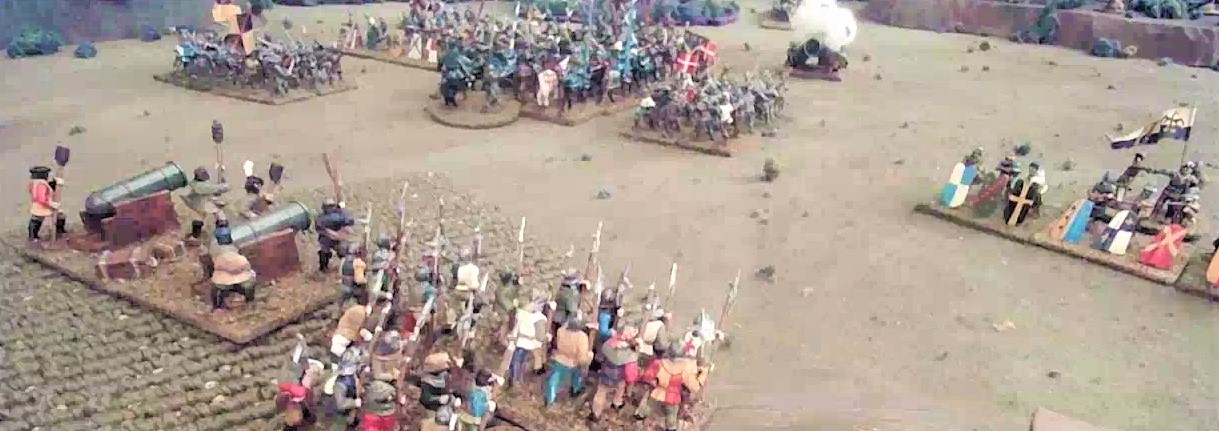
Cannon, Crossbowmen, and some Billmen standing in reserve watch the enemy as the knights slaughter each other - their part has already been played.
Archers, Crossbowmen, Cannon, and Irregulars may always fire. Horsemen equipped with missile weapons (e.g., crossbows, handguns, or javelins) may also fire (specify by scenario). Other troop types may not fire. Cannon can fire at any target within 24 inches. All other fire has a range of 12 inches. The range is the shortest line of fire between the firing base and any base in the target unit.
Fire may only be conducted from the front of any base in the unit, and up to 45 degrees to either side of facing outward, measured from the edge of the base. Only the front rank of bases may fire.
Targets for fire must be within range and arc, as well as visible to the firing unit (within line of sight). Line of sight is determined by having a clear line between both front corners of the firing base and any point on a base in the Target unit. Line of sight extends 3 inches into, out of, or through woods or similar concealing terrain unless stated otherwise by scenario. All units block line of sight - you cannot shoot through enemy units.
Only bases within range, arc of fire, and with a clear line of sight may fire, but not all bases in a firing unit are required to fire on the same Target. Some bases may be unable to fire, but the action may still be taken by those which are. Fire for each Target in a single Fire action will be conducted separately with the app. However, all fire on a single Target in a single Fire action must be performed with one calculation in the app. (If a Fire action has two Target units, then two calculations are performed with the app to determine the results - one for each target unit).
For any fire except Cannon, closer targets must be preferred to those which are further away. If equidistant, the player may decide which to fire on. It is always permitted to concentrate all of a unit's fire on the closest target unit, measured as the shortest distance between the firer and target. Split fire on a target which is closer only to some of the bases in a firing unit is always optional, and performed according to the player's choice. Cannon may select any valid Target for fire, regardless of proximity, but may only conduct fire with the app on any given Target once during the action.
When calculating strength rations for setting modifiers in the app, the number of firing bases (for the Actor) is compared to the total number of bases in the Target unit. "Outnumbered" is any difference in size which is more than exactly equal in bases, but which is less than fully twice ("Badly Outnumbered").
Charges are a mechanism for initiating a combat with an enemy unit which is not already engaged in a melee. To make a Charge, a unit must be able to wheel and then move directly forward until some part of its front is in contact with some part of the target unit. This movement may not cross the frontage of another enemy unit within 1 inch. Cannon and units in "march" formation may not Charge, nor may Irregulars when in the open except against other Irregulars or Cannon.
Frontal charges against Archers and Crossbowmen may involve taking fire during the Charge action. This is done exactly as for normal Fire actions. If a "devastating fire" results (the loss of 2 Status Levels) then the charging unit will fail to contact its target, and end its move an inch short. No Melee action will follow. Archers and Crossbowmen who have already acted for the turn will not be able to perform a Fire action at a charging unit.
When Charged, Irregulars and Horsemen may attempt to evade the Charge. Once the Target unit has made its evade movement - which is performed like any other movement, including paying for the initial facing change by the evading unit - and movement remaining to the charging unit may be taken, in an attempt to contact the target. Other Target units may not be contacted, even if they are exposed by the evade move. This charge movement in pursuit of an evading Target may not cross the front of a any non-Target enemy unit within 1 inch.
Note that evade moves will use the evading unit's action for the turn.
Whether contact (and a melee) results from a Charge action or not, any unit which Charged, evaded, or made a Fire action is considered to have acted for the turn.
Charges may not involve a change of formation of any type on the part of the charging unit. Unit depth and frontage must remain the same as at the start of the move. Only a wheel, followed by movement directly forward is allowed. If contact is made, the front of the charging unit will wheel to either left or right in order to maximize the amount of contact between the two units.
When a unit makes a Charge action resulting in contact, and a Melee action is made, the "Actor is Charging" box must be checked. This box is not important for conducting the Charge action itself - only the immediate Melee action occurring as part of that charge.
Note that it is not possible to Charge two units at a time, even if the Charge movement will bring the charging unit into contact with more than one enemy unit. The first enemy unit which would be contacted must be declared as the Target of the Charge. If there is a choice of Targets, it is the charging player's decision. Note that it is allowed for more than one enemy unit to be contacted by the move, and that both of the contacted enemy units may be involved in the combat, but the one designated the Target must be involved in the combat. The other may become a Supporting unit (see below).
Whenever an activated unit is in contact with an enemy unit, there may be a combat. This is the case if any part of the front of either unit is in contact with the enemy. This situation may result from a Charge action, in which case a Melee action is immediately made. This may result from two units being in combat at the start of the turn, which is termed an "ongoing combat."
Combat involves at least two units - an Actor and a Target - but may also involve others. Any unit involved in a combat which is neither the Actor nor the Target is termed a "Supporting" unit. The Actor is always the activated unit which triggered the combat - the unit which has just made a Charge action, or the unit selected by a player to be activated. The Target unit is either the one designated in the Charge which was just conducted, causing the melee, or is one of the enemy units (if more than one) in contact with the front edge of the acting unit, in a case where no Charge action has taken place immediately before the Melee. The acting unit's player may select which enemy unit is the Target under circumstances where there is more than one possibility.
Supporting units do not change the modifiers entered in the game app, except for the determination of force ratios, and whether the Acting or Target units are taken in flank or rear. Supporting units include:
All units involved in the combat will be considered to have acted, whether they are the Acting unit, the Target unit, or a Supporting unit. Any Leaders attached to any unit involved in the combat will also be considered to have acted for the current turn, and may not be subsequently given an Initiative.
A unit is considered to be "Taken in Flank/Rear" for game purposes if any enemy unit has contacted them on this sides with any part of its front.
After a Melee has been conducted, any unit which is contacted on the flank, but which is not contacted on the front, may choose to change facing to face any contacted flank. This is always optional, and may only be done once per turn by any given unit. Note that flank contact does not include front-corner contact with an enemy unit: contact must be made along the side of the unit, on the rear of the unit, or on a rear corner. Front corners are only considered to be a part of the unit's front facing.
For determining force ratios in a Melee action, all bases in the involved units are counted, regardless of whether they are in contact or not, or have already been engaged in a Melee action during the turn. (In Medieval combat, soldiers would press forward into the action [or shirk], unconstrained by the training which was common in later periods!)
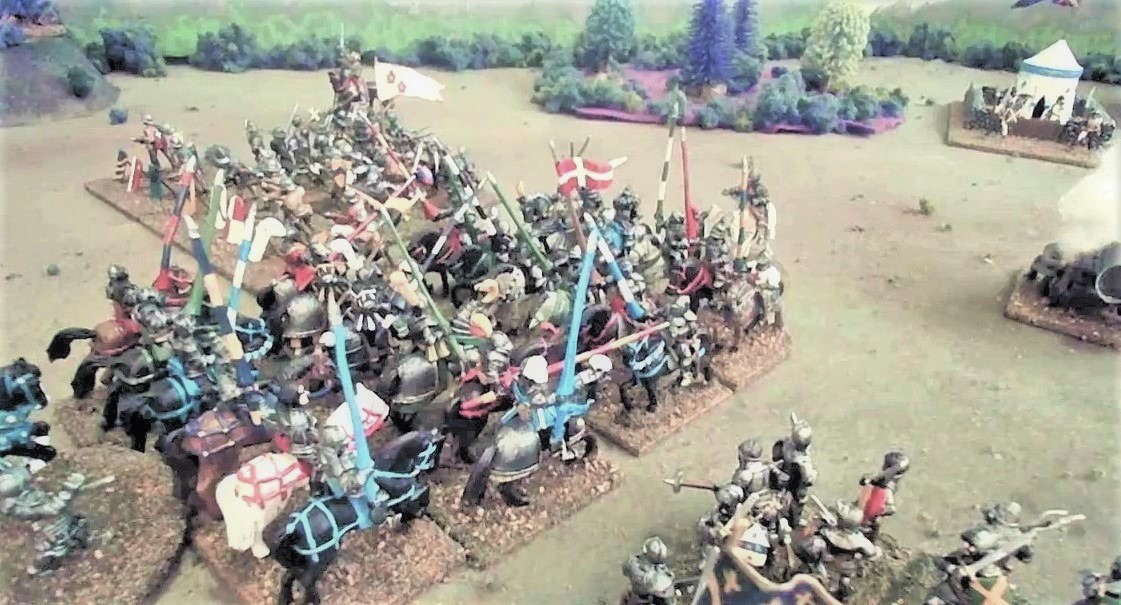
Mounted knights clash...
When a Melee action is taken, but does not result in the destruction of one side or the other, the units will remain in contact after acting. This is considered to be an ongoing combat. Whenever either unit is activated, a new Melee action will be taken. There are some special cases which occur when an ongoing combat is involved.
One of these is when an activated unit attempts to perform a Retire action. If successful, the retiring unit will pull out of the combat and a Melee will not be fought if contact is broken. If unsuccessful, an immediate Melee action will be made.
If a Regroup action is made by a unit in an ongoing combat -- something which requires the activating Leader to be attached to the unit - there will be an immediate Melee action, regardless of whether the Regroup action was a success or failure. The activating unit (the one attempting to Regroup) will trigger the Melee action, and its Leader will be involved in this Melee. Note that units which are contacted on more than one face at once (to front and flank, to rear and flank, etc.) may not perform Retire actions.
It is possible to charge into an ongoing combat, so long as the Charge action would involve no interpenetration of units, even if otherwise allowed (this is important: no interpenetration of units!). In such cases, neither evasion nor defensive Fire are allowed by the unit which is the Target of the Charge. Units in the Melee on both sides which have already acted may influence it as Supporting units (see above). The Target will engage in the Melee regardless of whether it has already acted or not.
Unit Status is a measure of how a unit is currently functioning, in terms of morale and losses. Combat outcomes are expressed as a change in Unit Status. All units begin the game with their full strength known (the number of bases in the unit), and all have a Unit Status of "OK". Unit Statuses are:
OK: The unit is good condition. The loss of bases does not stop a unit from having this status.
Disordered: The unit is in disarray. This situation is very common, and can be corrected by having the unit make successful Regroup action.
Demoralized: The unit is in a state of disarray bordering on panic: this is almost "sauve qui peut" territory. The situation can also be recovered from by Regrouping, but it may take more than one action.
Destroyed: The unit's soldiers have panicked, surrendered, become casualties, died, etc., and it is removed from play. Any time a unit has lost a full half or more of its starting number of bases, it is immediately destroyed.
Gaining a Status Level means going upward in the list above, and losing a Status Level is movement further toward the bottom of it. For example, an unit with an OK Status Level which goes down two levels will have a new Status Level of "Demoralized". Note that the Status Level does not correspond to the number of bases lost until the unit is destroyed. A unit with no losses can be Disordered or Demoralized, and a unit which has taken losses can be OK or have any other Status.
When an OK unit loses a Status Level, it becomes Disordered. When a Disordered unit loses a Status Level, it becomes Demoralized. When a Demoralized unit loses a Status Level, it loses a base. When a Demoralized unit loses two Status Levels, it loses two bases.
Any outcomes from Fire or Melee actions are implemented immediately. The exception to this is missile fire occurring at the end of the turn, which is simultaneous: any firing unit will make their Fire action before suffering from fire taken during the same portion of the turn.
Note that Disorder and Demoralization do not stop a unit from being activated. In many cases, however, it will reduce their effectiveness. These units may still move, charge, fire, and fight. (A certain degree of disorder is basically inherent in all Medieval military formations!)
When a unit charges into a combat and destroys its enemy, it must move forward to occupy the space vacated by the Target of the Melee. In any other circumstance, such a move on the part of the Actor in the Melee is optional. In both cases, the occupying move is only permitted if no other enemy units are in contact with the Actor of the Melee.
Enemy camps and baggage trains may be destroyed if they are in contact with an enemy unit at the end of the turn, but only if the unit destroying the camp or baggage train is not itself in contact with an enemy unit. Once the camp or baggage train is destroyed, the destroying unit(s) will immediately become Disordered, reflecting the fact that troops will inevitably break ranks to loot. Units which are already Disordered will become Demoralized, reflecting an additional level of indiscipline (although not panic). Base losses will never occur from such a contact.
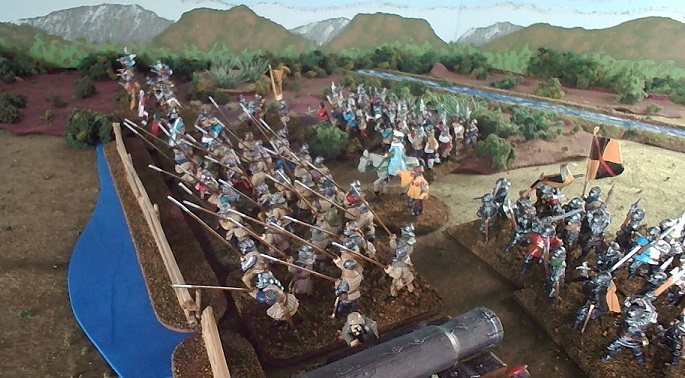
The rebellious Liegeois pikemen and their allies are deployed behind their flooded ditch and defensive works, but it may not be enough to stop the Duke of Burgundy and his knights. A snapshot from a refight of the Battle of Brustem, 1467.
Each army in a battle is given a Break Point. This is the total number of units in the army, also counting the baggage or camp as a unit if there is one. Each units adds one to the total, and Leaders are not counted. As the battle progresses, each side will keep track of how many points it has lost toward breaking. The status of each army is checked at the end of each turn. Once the total of points toward breaking equals or exceeds the Break Point, the army is broken, and has lost the battle. It is possible for both sides to lose in the same turn, resulting in a draw.
The points counted toward breaking are calculated by adding the following:
For each Irregular, Horsemen, Levy, Archer, or Crossbow unit destroyed: 2 points
For each Cannon, Pikemen, or Footmen unit destroyed: 3 points
For each Knight or Foot Knight unit destroyed: 4 points
For each unit currently Demoralized: 1 point
For a killed/captured enemy Army Commander: 3 points
For a killed/captured Battle Commander: 2 points
For a sacked camp/baggage train: 3 points
This game was created to allow for remote games played using actual miniatures viewed by players over remote conferencing systems such as Skype or Zoom. This was mainly driven by the realization that - while they can be easily played using "virtual" miniatures on platforms such as Table Top Simulator - the Art de la Guerre games which we had played before lockdown were no longer feasible using real miniatures. A Bloody Dismal Fight is very much inspired by ADLG, but there are major changes to the system to meet the needs of remote gaming. It is not the same game!
As we conducted more remote games of different types, we learned several important facts. Games needed to be less finicky in terms of positioning of units on the tabletop. Lots of small units - a feature of many game systems, ADLG included - make for a slow and irritating game. It is too difficult for players to see the tabletop, and when each move must be described verbally to a game master, the entire thing quickly loses its appeal. Further, dice rolling - a critical part of the game - also becomes less important, because the only person who sees the rolls is either the player or game master, depending on how you do it. Virtual die rollng systems do exist, but you quickly reach a point where the dice become a distraction rather than a feature. Why not let the game system roll the dice?
Games also need to be relatively shorter than face-to-face games, because communications over the internet are inherently more tiring than in-person ones. It is also easier to get bored when it is the other guy's go, since there is not as much to see. When you are communicating through a system which only supports one spoken conversation at a time, side-talk is impossible. And you cannot walk around the table and admire it!
All of these factors have fed into the current design. Units are fewer in number and larger, requiring fewer moves. Play goes back and forth between sides more rapidly, so that the game remains more interactive, leaving less uninterrupted "down time" for players. Armies break easier and faster, to accommodate the shorter overall length of games. The use of the app actually makes play go faster, since there is little time spent looking modifiers up or consulting charts in the rules, or, for that matter, rolling dice. This is a benefit because the general tendency of gaming remotely is to slow play down - anything which can be done to speed it up is welcome. (Since remote play of this type is, by its nature, moderated by a game master, anything which helps the GM get things resolved faster is a big plus. They are already sitting at their computer or using their device!)
ADLG and similar systems are designed for tournament play, since that is perhaps their primary use. Since there aren't any remote miniatures tournaments, that was simply not a consideration here. This leaves the designer freer to rely on player interpretation and scenario design, which again allows for a simpler game overall. (The rules lawyers can simply be ignored for a change!)
Another aspect of this game is that - unlike ADLG and other Ancients and Medieval systems - it narrowly focuses only on the late middle ages in Western Europe. Because the range of troops types is much narrower than it would be for a generic system, the game app can make correct assumptions which it could not do for a game with a broader scope. This again speeds play, since it removes the need for some otherwise-necessary input to conduct game actions.
Ultimately, this game became less and less similar to ADLG as it was developed. In the end, the feel was perhaps similar, but the game itself had changed significantly, becoming its own thing entirely. I hope players enjoy it for what it is, even after we are free to go back to the in-person gaming which has always characterized this most social of hobbies.